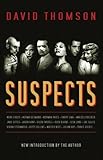2 CommentsReply |
MenuLatest GadetsRecent Reviews
Archives
|
Notcot
Gizmos, Gadgets, Noir and Steampunk
2 CommentsReply |
|
Copyright © 2025 Notcot All rights reserved. Theme by Laptop Geek. Site by I Want This Website. | Privacy Policy.

This has got to be one of the hardest books to describe I’ve come across. You could fairly label it any (or all) of the following: meditation on film noir, meditation on the American psyche, film buff fanfic, partial encyclopedia of film characters, or experimental fiction. Thomson is an eminent film critic and biographer, and back in the early ’80s, he was approached to put together a dictionary of film characters. As he thought about the project, the more problematic it seemed to him. So he reconceived it by focusing on the characters from a core of classic noir films and planning out how they might have interacted.
The book unfolds as brief biographies of almost 100 characters from around 40-50 films, mostly from the 1940s-1970s era. The characters are reimagined as they interect with the “real” world as well as the “reel” world of others in the book. So, for example, the characters Noah Cross (Chinatown) and Nora Desmond (Sunset Boulevard) are shown to have been lovers in the 1920s, while Ilsa (Casablanca) dies in the 1963 plane crash that killed U.N. General Secretary Dag Hammarskjöld . Meanwhile, some characters are revealed to be relatives of others and so forth. As readers of Thompson’s Biographical Dictionary of Film know, he is a gifted and incisive biographer, and his fictional work here is equally skilled. All of which makes for interesting (and sometimes amusing) metafare, but there’s something deeper at work.
It’s not at all clear who the first-person writer of these mini-bios is (it’s clearly not Thomson), nor how he or she is related to them, or what the purpose of all the succession of bios is. However — there is a big clue in the form of a map at the very beginning. That said, the clue didn’t register with me, and about 1/3 of the way into the book, I was confused enough to start skipping around a bit. At the back, I found a family tree that unlocked the riddle and sent me back into the book, flipping back and forth to connect the dots (one of the book’s juicier pleasures arrives once the reader works out the identity of Travis Bickle’s (Taxi Driver) father.) As befits a book of such odd construction and narrative, one can interpret it many different ways — as a statement on identity, a statement on American values, a statement on aging, a statement on the function of film, or even just an odd entertainment.
Whatever one’s reaction, it’s definitely worth checking out by those interested in experimental approaches to fiction, as well as those with a penchant for film noir. It would certainly be to the reader’s advantage to be familiar with at least half the films referenced by the book, otherwise the character sketches are going to be hardest to contextualize in the mind. I was familair with about 3/4 of the characters in the book, and found the unfamiliarity with the other 1/4 to detract from the grip of the book.
Rating: 4 / 5
I read “Suspects” on the strength of Thomson’s book about Welles; I enjoyed this dark trawl through the noir swamp even more. If good film criticism sends you back to the films, then this book does exactly that. It is a book that defies description – but it treats the noir world as if it were real, rounding up the usual suspects in such a way that they become, in strange ways, connected. If you ever wondered about, say, Travis Bickle’s early years, then are you in for a surprise!
Suffice to say, if you love noir and would like to get down and dirty with some of your favourite characters, this is the book for you.
Rating: 5 / 5